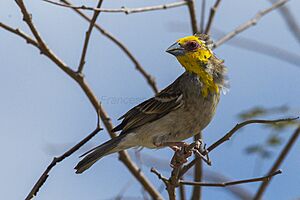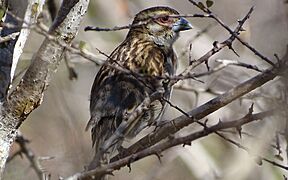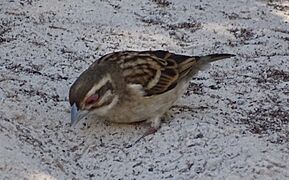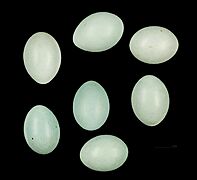Sakalava weaver facts for kids
Quick facts for kids Sakalava weaver |
|
|---|---|
 |
|
| ↑ male, ↓ female | |
 |
|
| Conservation status | |
| Scientific classification | |
| Genus: |
Ploceus
|
| Species: |
sakalava
|
The Sakalava weaver is a special type of bird that lives only on the island of Madagascar. It's also sometimes called the Sakalava fody. These small birds are about 15 cm (5.9 in) long, which is about the length of a pen. They weigh around 20–28 g (0.71–0.99 oz), which is lighter than a candy bar!
Contents
About the Sakalava Weaver
How the Sakalava Weaver Got Its Name
The Sakalava weaver was first described by a scientist named Gustav Hartlaub in 1861. He studied a bird that was collected by Victor Sganzin during an adventure in Madagascar. The name sakalava comes from the Sakalava people, who are a group living in Madagascar. Their name means 'people of the long valleys'.
In 1891, James Sibree gave the bird its first English name: Sakalava Weaver-bird. Today, the official name is Sakalava weaver, decided by the International Ornithological Committee. You might also hear it called Sakalava Fody. In the local Malagasy language, people call it by names like fodibeotse, fodisahy, tsiaka, draky, and zaky.
Where Do Sakalava Weavers Live?
Sakalava weavers live in small groups. You can find them in the dry forests and scrubland areas in the north, west, and south of Madagascar. Their favorite places to live are dry forests and dry shrublands in warm, tropical areas.
What Do Sakalava Weavers Look Like?
The adult male Sakalava weaver looks different during the breeding season. His head and the top part of his chest turn bright yellow. The rest of his belly is light grey, and his wings are light brown with white tips. A cool feature of the male is his bright red eye-rings and a silver beak that extends up into his forehead in a 'V' shape. When it's not breeding season, the male's head turns dark brown, and his chest becomes pale grey with white sides.
The female Sakalava weaver looks a bit like a house sparrow. She has a pale, almost white chest and a duller, slightly pink beak. She also has red rings around her eyes, and sometimes you can see small flashes of red near her eyes.
How Do Sakalava Weavers Build Their Nests?
Like other true weaver birds, the Sakalava weaver builds a special nest with a roof. They weave their nests using strips of grass leaves. They also use strips from palm fronds or other weaving materials they find in villages. The top of the nest is woven directly around a tree branch or attached to a short woven stalk.
The nest is shaped like a retort, which means it has a pear-shaped room for nesting and a long tunnel for the birds to enter. The nest's fabric is thin but strong. The entrance tunnel might be a bit see-through and can be a little wider at both ends.
Gallery







